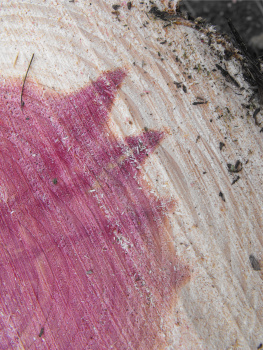
How long will a cedar post last?
 Some
of you may be wondering about our decision to use untreated cedar posts
as the foundation of our
shed. It
almost certainly wouldn't pass the building inspector's eagle eye, but
luckily small sheds are often exempt from code restrictions (especially
when you live out in the middle of nowhere.)
Some
of you may be wondering about our decision to use untreated cedar posts
as the foundation of our
shed. It
almost certainly wouldn't pass the building inspector's eagle eye, but
luckily small sheds are often exempt from code restrictions (especially
when you live out in the middle of nowhere.)
How long will the red
cedar posts last in the ground? Your guess is as good as mine,
but I suspect they'll last a good long while. Red Cedar (Juniperus
virginiana) wood contains substances that
naturally kill termites, but it's hard to say
whether the wood is as effective against fungal rots.
The red heartwood, from
which Red Cedar gets its name, is the most hardy part. Mark
carefully chose large cedar trunks with plenty of heartwood, figuring
that even if the pale sapwood rots away, enough heartwood will remain
to support our shed. People have been using Red Cedar as
untreated fenceposts for a long time, and Mother
Earth News notes that they will last for 15 to 20 years. Since our supports
are significantly thicker than typical fenceposts and will be protected
on the top from water, I wouldn't be surprised if they lasted for
several decades.
At Uxmal, we learned that Mayans
traditionally tore down their homes and started fresh every 52
years. It just makes sense to me to create a structure that uses
fewer resources (and costs less money), but that will need care and
maybe will even have to be replaced in our lifetime. So far,
we're on track to build the shed for around $6 per square foot,
including insulation. At that rate, we could rebuild our shed
every 5 years for the rest of our lives and still come out ahead of
someone who used more traditional methods.
| This post is part of our Building a Storage Building from Scratch
series.
Read all of the entries: Part 1: Foundation
Part 3: Walls and scavenging lumber
Part 5: The roof
|
Want more in-depth information? Browse through our books.
Or explore more posts by date or by subject.
About us: Anna Hess and Mark Hamilton spent over a decade living self-sufficiently in the mountains of Virginia before moving north to start over from scratch in the foothills of Ohio. They've experimented with permaculture, no-till gardening, trailersteading, home-based microbusinesses and much more, writing about their adventures in both blogs and books.
Want to be notified when new comments are posted on this page? Click on the RSS button after you add a comment to subscribe to the comment feed, or simply check the box beside "email replies to me" while writing your comment.

The cedar heartwood will last much longer that 15 years. I've seen fence posts where only the heartwood was left and it thin as a pencil. As for codes, around 25 years ago, the feds approved wood foundations, which are treated plywood fastened to treated 2 x6s.